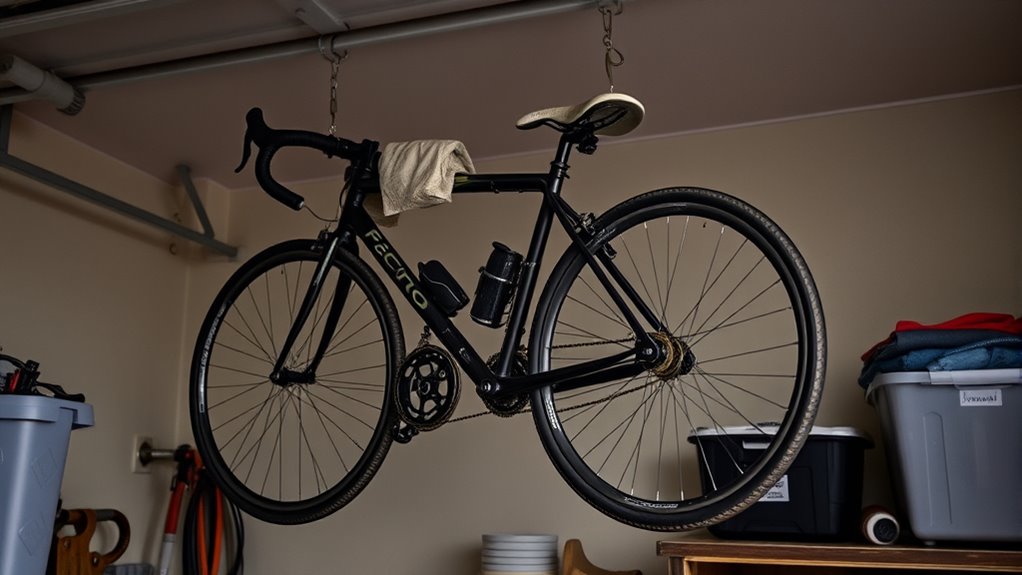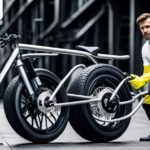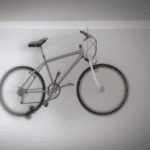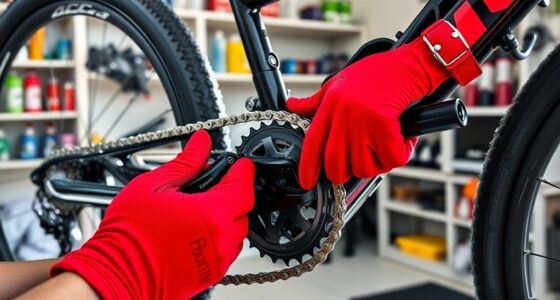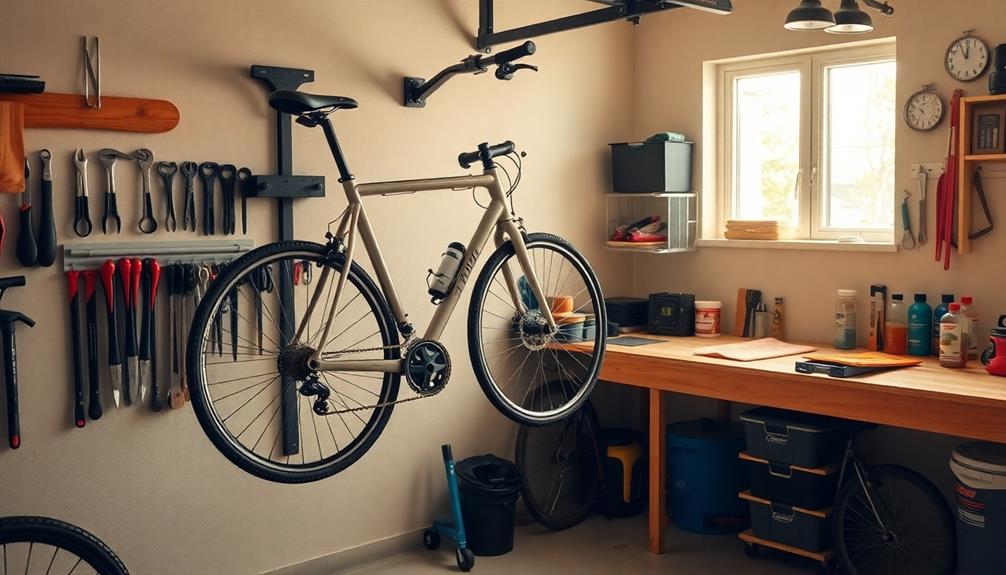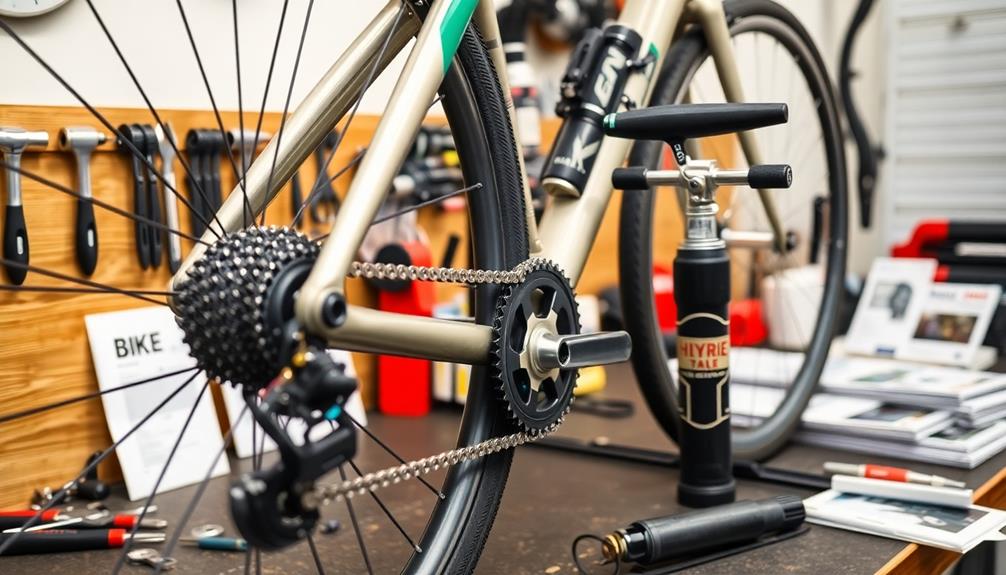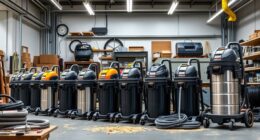To store your bike off-season and prevent damage, start with a thorough cleaning using mild detergent, then dry it completely and apply lubricant to moving parts like the chain and derailleurs. Choose a dry, temperature-controlled spot, elevate the bike on wall hooks or stands, and cover it with a waterproof, ventilated cover. Inflate the tires properly, remove batteries and accessories, and inspect regularly. Keep these tips in mind to protect your bike longer—there’s more to discover below.
Key Takeaways
- Clean and thoroughly dry your bike, paying special attention to the chain, cassette, and derailleur, then lubricate moving parts.
- Store the bike in a dry, temperature-controlled space, elevating it on wall hooks or stands to prevent flat spots.
- Remove batteries and accessories, storing batteries separately at room temperature with a partial charge.
- Inflate tires to recommended pressure and keep the bike elevated to maintain shape and prevent damage.
- Cover the bike with breathable, waterproof covers to protect from dust, humidity, and environmental elements.
Thoroughly Clean and Dry Your Bike Before Storing
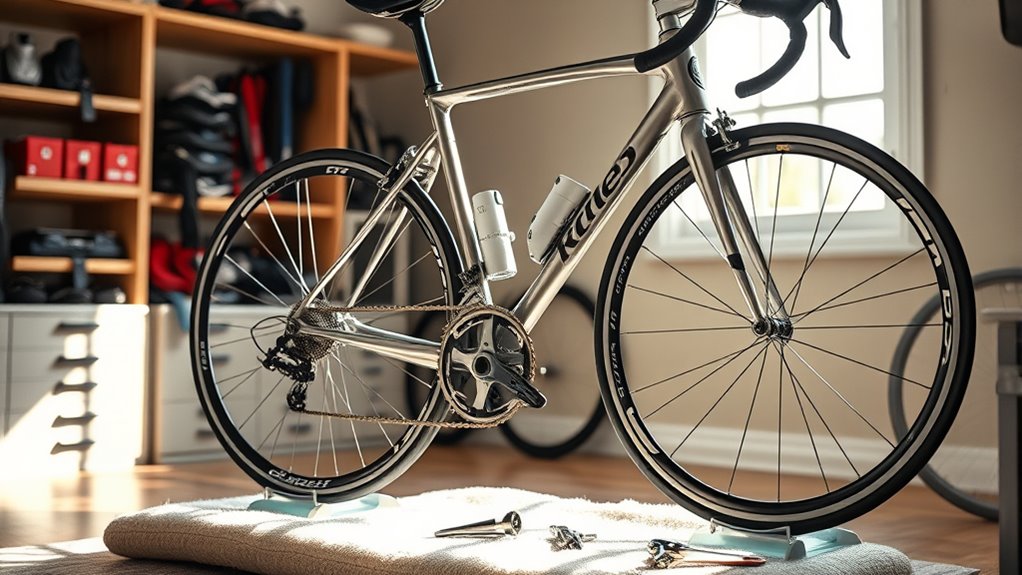
Before storing your bike for the off-season, it’s essential to thoroughly clean and dry it. Start by using a mild detergent and warm water to scrub the entire bike, paying close attention to hard-to-reach areas like the chain, cassette, and derailleur. This helps remove dirt, grime, and debris that can cause rust or damage over time. Rinse the bike thoroughly, but avoid high-pressure water that might harm seals or bearings. Once clean, dry your bike completely with a clean cloth or compressed air to prevent moisture from causing rust or corrosion. Proper drying is vital. Afterward, consider applying a thin layer of lubricant to the chain, derailleurs, and brake cables to protect against rust and keep your bike in good shape for the next ride. Additionally, understanding filtration systems can help you choose the right cleaning products that won’t damage sensitive components.
Apply Lubrication to Moving Parts and Components
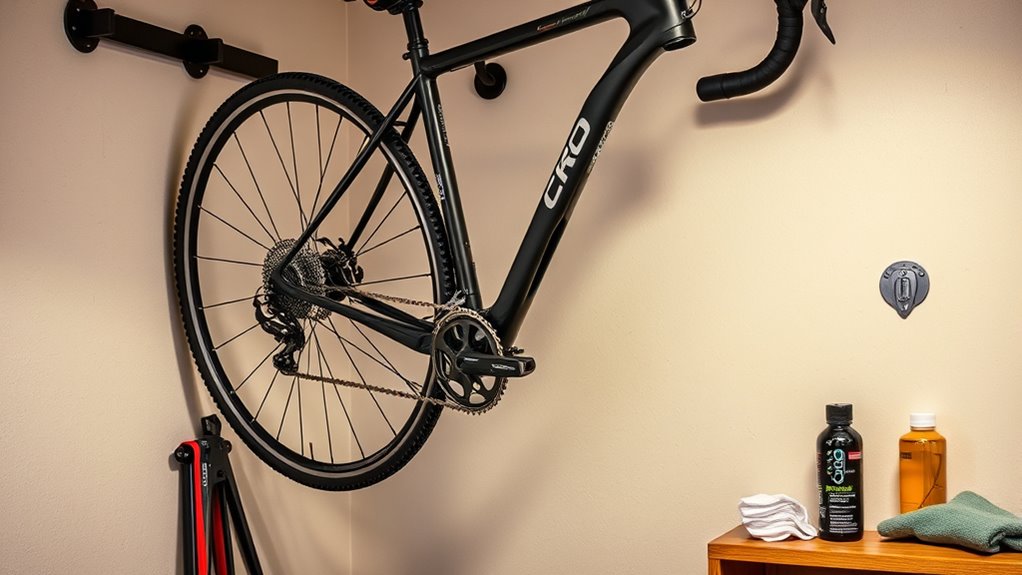
After thoroughly cleaning and drying your bike, it’s time to apply lubrication to its moving parts. Lubricate the chain, derailleurs, brake cables, and gear cables to reduce friction and prevent rust during storage. Use a bike-specific dry lubricant on the chain to attract less dirt and keep it running smoothly. Be careful not to over-lubricate; a light, even coat is enough to prevent buildup and make future cleaning easier. Proper lubrication helps protect metal components from moisture, reducing the risk of corrosion over the off-season. Additionally, storing your bike in a dry, sheltered location can further minimize exposure to environmental factors that cause metal corrosion. You can also consider headphone options to ensure your bike’s components are in optimal condition before storage. Regularly inspecting and maintaining lubrication levels can help prevent rust formation and keep your bike ready for riding when the season resumes. Reapply lubricant periodically if your bike stays stored for several months. This simple step ensures your bike remains in good condition, ready for a smooth ride when you take it out again.
Select an Ideal Storage Location and Prepare Your Bike
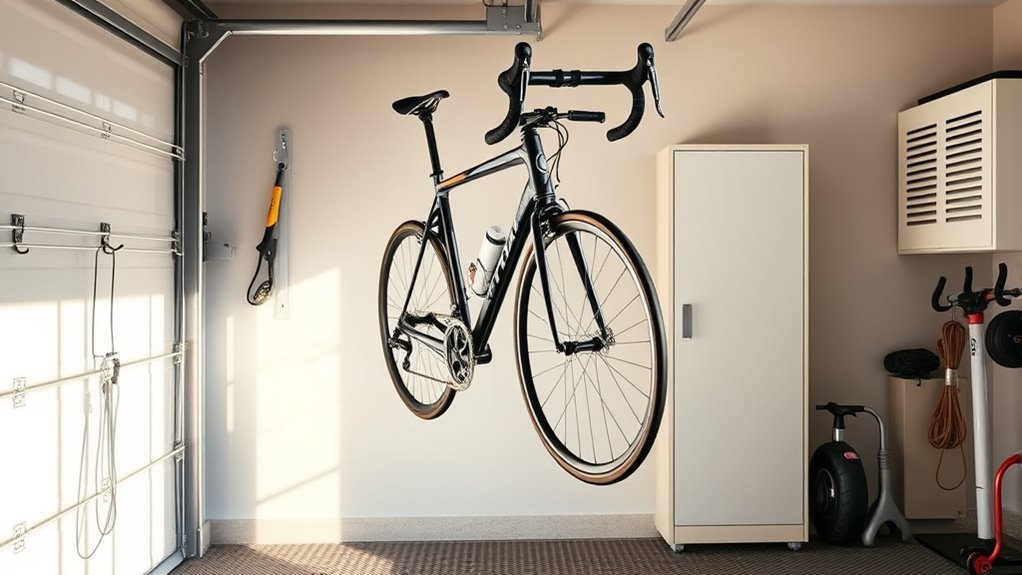
Choosing the right storage location is essential to protect your bike from rust, moisture, and damage over the off-season. Opt for a dry, temperature-controlled space such as a spare room, closet, or garage to prevent damage caused by humidity. Elevate your bike store by hanging it on wall hooks, ceiling hoists, or using stands to avoid flat spots and reduce stress on tires and rims. Cover your bike with waterproof covers or tarps that have proper ventilation to shield it from dust, humidity, and condensation. Before storing, make sure your tires are inflated to the recommended pressure to prevent deformation. Additionally, remove batteries and accessories, and lubricate moving parts to keep your bike in good condition during its time off. Incorporating proper storage techniques can further help preserve your bike’s condition, including ways to manage pet hair and other potential contaminants in your storage area. Regular inspections and climate control can help prevent corrosion and extend the lifespan of your bike during the off-season. Proper ventilation is also vital to minimize moisture buildup and maintain optimal storage conditions.
Properly Inflate Tires and Elevate the Bicycle
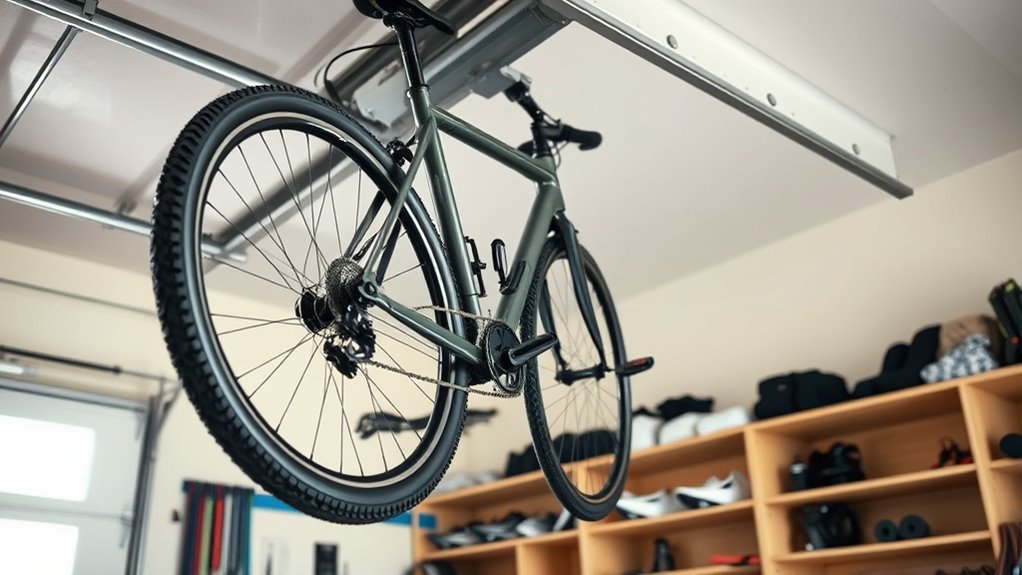
To guarantee your bike stays in top shape during storage, start by inflate tires to their recommended pressure range—80-130 psi for road bikes and 25-35 psi for mountain bikes. Properly inflated tires help prevent flat spots and rim deformation during long-term storage. Next, elevate your bike using wall racks, ceiling hooks, or freestanding stands to reduce stress on tires, rims, and the frame. Elevating the bike keeps tires off the ground, preventing moisture buildup and tire damage. If stored on the ground, rotate or move the tires periodically to distribute pressure evenly and avoid uneven tire wear. Additionally, maintaining proper tire pressure and elevation helps preserve your bike’s shape, prevent flat spots, and ensures it’s ready for riding when the season resumes. Regularly inspecting your bike for signs of damage or corrosion during storage also prolongs its lifespan. Proper bike maintenance during storage can further protect against deterioration caused by environmental factors. Using a bike generator to power small maintenance tools or lights can also be a sustainable way to care for your bike during the off-season. Incorporating smart storage solutions can help keep your bike protected from dust and pests, extending its usable life.
Remove Accessories, Batteries, and Perform Routine Inspections
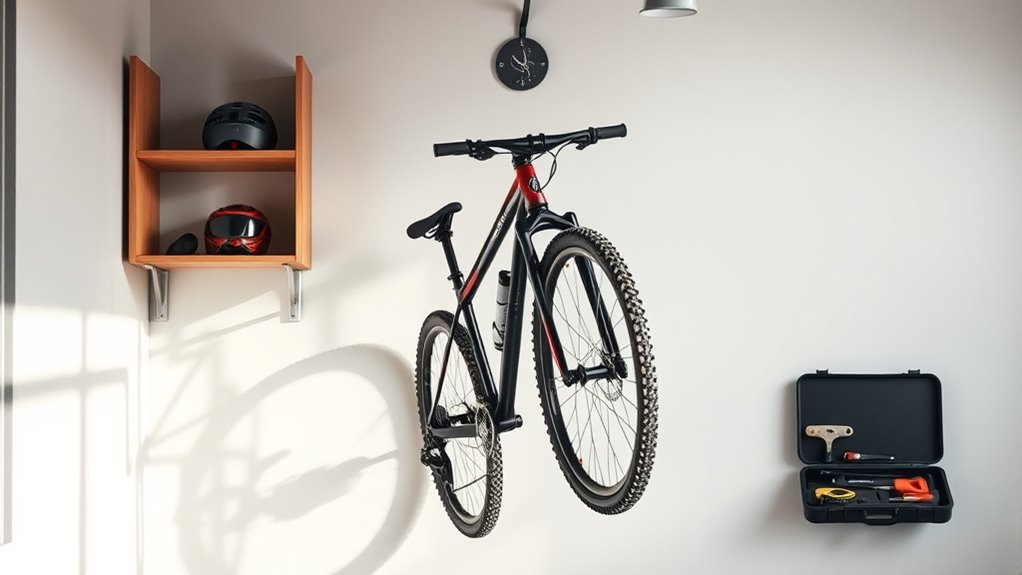
Before storing your bike for the off-season, it’s important to remove all accessories and batteries to prevent damage and moisture buildup. Take off items like water bottles, pumps, and bags, which can trap moisture and cause corrosion or mold. Remove all batteries from electronic components and store them separately at room temperature, ideally at 50-70% charge, to extend their lifespan. While preparing your bike, perform routine inspections by checking for rust, loose bolts, or damaged cables. Address any issues before long-term storage to avoid further deterioration. Additionally, inspect the tires and inflate them to the recommended pressure to prevent flat spots. Regularly spinning the wheels and moving the chain during storage can help prevent seizing and catch early signs of wear or corrosion. Incorporating proper maintenance techniques and seasonal storage tips helps ensure your bike stays in good condition during the off-season. Implementing environmental controls such as storing your bike in a dry, temperature-controlled space can further protect it from humidity and temperature fluctuations. Being aware of potential security risks during storage and taking precautions can also help prevent theft or vandalism.
Frequently Asked Questions
How Do You Store a Bike When Not in Use?
When you’re not riding your bike, you should store it in a dry, temperature-controlled space like a garage or closet. Hang it on wall mounts or ceiling hooks to save space and prevent tire deformation. Remove batteries, electronics, and accessories, keeping them in a cool, dry place. Inflate the tires to the recommended pressure, and clean and lubricate your bike to safeguard it from rust and make sure it’s ready when you want to ride again.
How Do I Protect My Bike in Storage?
You want to safeguard your bike in storage, but neglecting proper care invites rust and damage. To prevent this, apply a protective wax or corrosion inhibitor to create a barrier against moisture. Elevate your bike on wall hooks to avoid ground moisture and deformation. Cover it with a breathable tarp to guarantee airflow, and remove batteries and electronics. Keep the storage space dry, ventilated, and temperature-controlled for ideal protection.
How to Store a Bike Outside Without It Rusting?
To store your bike outside without it rusting, start by applying a high-quality wax or corrosion inhibitor to metal parts, creating a protective barrier. Use a waterproof tarp with vents and grommets to shield it from rain and humidity. Elevate the bike on supports to avoid direct contact with moisture-prone surfaces. Regularly inspect and wipe it down, and choose a sheltered spot like a shed or under an overhang for added protection.
Is It Bad to Store Your Bike Outside With a Cover?
Storing your bike outside with a cover is like giving rust an invitation to party. If you use a waterproof, vented cover, you can shield it from rain while allowing moisture to escape. Just make sure your bike is dry beforehand and store it in a sheltered spot with good ventilation. This way, you’re helping your bike breathe and stay protected, rather than trapping damaging moisture underneath.
Conclusion
Storing your bike properly during the off-season keeps it in top shape for next riding season. For example, Jane stored her bike in a cool, dry garage, following these steps, and when spring arrived, her bike looked brand new and was ready to ride. Don’t neglect these simple tips—clean, lubricate, and store correctly—and your bike will thank you with years of smooth rides ahead. Proper storage is your bike’s best defense against damage and wear.
